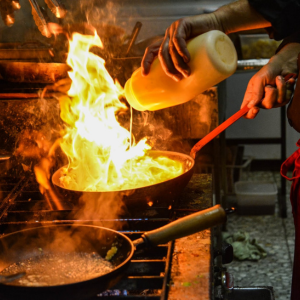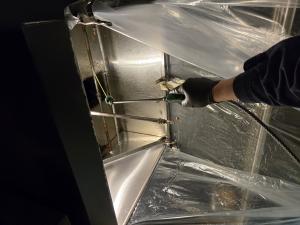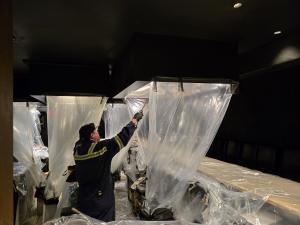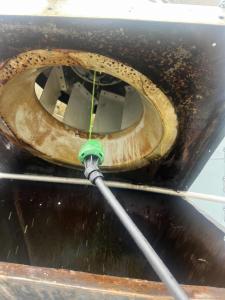
From Smoke-Filled Kitchens to Code-Compliant Canopies: A History of NYC’s Restaurant Hoods

The story of commercial hood cleaning and ventilation in NYC is a tale of fire and innovation.
BROOKLYN, NY, UNITED STATES, June 25, 2025 /EINPresswire.com/ -- New York City’s restaurant kitchens weren’t always the high-tech, stainless-steel warrens we know today. In fact, the story of commercial hood cleaning and ventilation in NYC is a tale of fire and innovation. It spans from the smoky kitchens of the early 20th century to the modern era of strict codes, restaurant hood service schedules, and cutting-edge commercial kitchen hood installation. This journey blends compelling characters – from tenement cooks to FDNY inspectors – and landmark legislation that shaped how every diner meal gets cooked safely.“Back in the day, I rememba goin’ into joints where the restaurant hoods were drippin’ grease,” says Tony Russo, a veteran technician at Done Right Hood & Fire Safety, in a thick Brooklyn accent. “Ain’t nobody back then thought about professional hood and exhaust cleaning. We’d just scrape and pray the place didn’t burn down, ya know?”
Tony’s colorful recollection hints at a bygone New York, when kitchen ventilation was more art than science. Let’s dive into how we got from those grease-laden ceilings to today’s robust hood cleaning company culture in NYC.
In the early days of restaurant hoods, “ventilation” often meant little more than opening a window or relying on a brick chimney. Turn-of-the-century New York kitchens, from Lower East Side delis to Uptown chophouses, cooked on coal and wood stoves. These fuels filled kitchens with heat, smoke, and grease vapors – a dangerous mix in crowded city buildings. Grease fires were an ever-present risk, yet formal exhaust systems were virtually nonexistent.
The concept of a dedicated kitchen exhaust hood emerged in the early 20th century. In fact, the very first modern range hood was invented in 1926 by Theodore R.N. Gerdes. This innovation – essentially a metal canopy with a fan – was a game-changer. It offered a way to extract smoke and grease from the air above stoves, making kitchens safer and less suffocating. By the 1930s, large New York hotels and restaurants began installing primitive exhaust hoods and ductwork, though many smaller eateries still relied on natural draft.
Commercial kitchen hood installation in those days was rudimentary. Hoods were often custom-built sheet metal vents, and maintenance was minimal. Restaurant owners or staff might wipe off visible grease, but thorough hood cleaning wasn’t yet an established practice. It wasn’t uncommon to see blackened walls and ceilings above busy grill lines – visible evidence of grease buildup. Without regulation, each restaurant addressed cleaning (or didn’t) on their own terms.
After World War II, America’s restaurant industry boomed – and so did the incidence of dangerous grease fires. New York City’s fire marshals grew increasingly concerned as more diners, drive-ins, and pizza parlors installed fryers and flat-tops that belched grease-laden vapors into hoods and ducts. A spark from a grill or burner could turn those grease deposits into a ticking time bomb.
This post-war era saw inventors step up with new safety features for restaurant hoods. Between 1957 and 1965, an inventive entrepreneur earned several U.S. patents for advanced exhaust hood designs. These pioneering hoods introduced grease-extracting baffles (metal filter panels that trap grease), built-in fire dampers to block flames, and even early versions of water-wash cleaning systems in the hood plenum. In other words, the idea of an “automatic hood cleaning” mechanism was born in the 60s – decades before such technology became common. These patented concepts foreshadowed many later developments in keeping hoods clean and safe.
Equally important was the advent of built-in fire suppression for hoods. In the late 1950s, engineers began developing the first automatic fire suppression systems specifically for commercial kitchens. Instead of relying on a cook with a fire extinguisher, these systems could detect a blaze in the hood and flood the area with fire-fighting chemicals. One major manufacturer (a name New Yorkers now see on red tanks above every grill) released the first pre-engineered automatic hood fire suppression system in 1962. It used heat-sensitive fusible links to trigger dry chemical powder over the cooking line. Suddenly, a kitchen fire didn’t mean certain disaster – if your hood was equipped with this new tech. By the end of the 1960s, many NYC restaurants, especially chain fast-food outlets popping up in the outer boroughs, had installed these “Ansul”-type systems (named after a leading brand) to douse grease fires automatically.
However, having a sophisticated hood and suppression system was only half the battle. They needed to be kept clean and functional. A grease-clogged duct or a dirty fusible link could fail when it mattered most. The hood cleaning trade was still in its infancy – often just freelance cleaners or fire protection companies offering it as a side service. There was no standardized training or schedule. Some restaurateurs cleaned when they remembered (or when an inspector scolded them), and others only after a close call. Grease fires continued to plague the city.
“I seen what happens when a hood ain’t cleaned, and it ain’t pretty,” chuckles Sal Martinez, who’s been with Done Right since the 1980s. Speaking in a gravelly Staten Island drawl, he recalls, “One time a diner in Queens had an exhaust fan so gunked up it was growin’ stalactites of grease! We spent all night scrapin’ that mess. That kinda hood and exhaust cleaning was like archaeology – layer after layer of old grime. But it saved the owner’s butt from an FDNY shutdown, I tell ya that.”
Sal’s anecdote underscores a turning point: by the late 1970s and 80s, New York authorities were waking up to the importance of regular hood maintenance.
The real sea change in restaurant hood safety came with the rise of fire safety codes and national standards. Earlier efforts to govern kitchen ventilation existed – the National Fire Protection Association (NFPA) had included restaurant ventilation guidelines in other standards as far back as 1946. But these were piecemeal. It wasn’t until the 1980s and 90s that a comprehensive standard emerged to specifically tackle kitchen exhaust hazards.
In 1991, NFPA introduced NFPA 96: Standard for Ventilation Control and Fire Protection of Commercial Cooking Operations. For the first time, there was a uniform set of rules on how commercial kitchen exhaust systems should be designed, installed, cleaned, and maintained. Before NFPA 96, there were no consistent, nationwide standards for cleaning grease out of hoods and ducts – many kitchens were essentially on their own. This lack of uniform guidance led to wildly inconsistent practices, with some places neglecting cleaning altogether, leaving them “vulnerable to potential fire hazards”. NFPA 96 changed all that by mandating clear guidelines on cleaning frequency and requiring that certified professionals perform the work. In short, it professionalized the hood cleaning industry and made safety a priority.
Under NFPA 96 (and the local codes that followed), a typical NYC restaurant is required to have its hoods and ducts cleaned on a regular schedule – often at least once every three months for high-volume operations. In fact, failure to clean kitchen hoods and ducts is cited as a leading cause of restaurant fires. That sobering statistic, backed by NFPA research, spurred regulators to act. It’s why NFPA 96 and NYC’s fire code mandate professional cleaning on quarterly or even monthly intervals depending on a kitchen’s output. By cleaning away grease before it can ignite, restaurants dramatically reduce their fire risk. The numbers tell the story: according to the NFPA, over 85,000 restaurant and commercial kitchen fires were reported in the U.S., resulting in more than 5,000 injuries and 500 deaths. Grease accumulation in vents was a major culprit. Regulators knew prevention – via cleaning – was the key to bringing those numbers down.
New York City led the charge on enforcement. The FDNY began to roll out rigorous inspection programs in the 1990s. NYC’s fire code was updated to align with NFPA 96, meaning that if you ran a restaurant in the five boroughs, you had to keep proof of regular hood cleanings by a licensed contractor. The Fire Department started issuing Certificates of Fitness to qualified hood cleaners (today, a technician in NYC needs an FDNY W-64 certificate to clean hoods legally, and companies need a company license). With this credentialing, the city could hold cleaners and restaurants accountable. An FDNY-approved hood cleaning company would leave an inspection sticker on the hood, and the absence of that up-to-date sticker could earn a restaurant hefty fines or even closure.
By the early 2000s, failing to clean your hood in NYC wasn’t just risky – it was expensive. City laws introduced fines up to $10,000 for restaurants that neglected regular hood and exhaust system cleaning. Insurance companies, too, started requiring proof of compliance; a grease fire claim might be denied if records showed the hood hadn’t been cleaned as required. The message to owners was clear: get with the program or get shut down.
“Ever since the city started crackin’ down, you got no choice – you gotta clean dat hood on schedule,” says Maria D’Angelo, compliance manager at Done Right, with a thick Queens accent. “These days, if a joint in Manhattan skips their restaurant hood service, fuhgeddaboudit – the FDNY will be on ’em faster than you can say ‘grease fire.’ And they ain’t shy with the fines neither. But hey, it keeps everyone honest. Nobody wants their name in the papers for a kitchen fire.”
Maria’s blunt assessment highlights how legislation forced a cultural shift. What was once an afterthought – cleaning the greasy guts of the kitchen – became as routine as chopping onions.
As codes tightened, an industry bloomed. In the 1980s, a handful of dedicated hood cleaning outfits had appeared around the country. Sensing the need for shared knowledge, a small group of these professionals formed the International Kitchen Exhaust Cleaning Association (IKECA) in 1989. This organization set out to develop best practices and training for the niche craft of degreasing restaurant exhaust systems. (Interestingly, decades later in 2009, IKECA joined the American National Standards Institute to help write official standards for cleaning techniques – a sign of how far the field has come.)
In New York City, specialized hood cleaning companies multiplied in the 1990s and 2000s. Many were founded by former firefighters or tradesmen who understood the stakes. They advertised services like “complete hood and exhaust cleaning – from the flue to the rooftop fan.” Done Right Hood & Fire Safety, for example, emerged as one of the local leaders, emphasizing its FDNY certification and thorough approach. Today, these companies are fixtures of the NYC restaurant scene. Their crews arrive after closing time with power washers, scrapers, and chemical degreasers, ready to scour every inch of the exhaust system. They haul away buckets of grease, polish steel to bare metal, and leave behind a signed certificate that gives owners and inspectors peace of mind.
The work is dirty and often done in the wee hours, but it’s essential. “It’s a dirty job, but our crews love their work,” one company proudly states. And they have reason to be proud – their labor has undoubtedly saved lives and businesses. Consider that every year without a major grease fire is a direct result of these preventive cleanings. The public rarely hears about the disaster that didn’t happen – the blaze that never ignited because a duct was clean – but in the fire safety world, prevention is the quiet hero.
Fast forward to today, and a new restaurant in New York can’t get a permit without a proper restaurant exhaust hood installation in place. Architects and engineers design ventilation systems to meet strict building and fire codes. A Type I commercial hood (for grease-producing appliances) with a powerful upblast fan and baffle filters is standard in any kitchen that flips burgers or fries chicken. These systems must comply with NFPA 96 and NYC Mechanical Code specs from day one. Most are now paired with state-of-the-art wet chemical fire suppression (UL 300 compliant), automatic gas shut-offs, and even smart sensors.
Modern hoods are also quieter and more energy-efficient than their clanky ancestors. Some high-end installations include UV light or electrostatic precipitator units that break down grease particles before they can accumulate, reducing how often deep cleaning is needed. In dense Manhattan neighborhoods, where venting smoke out a rooftop could annoy upscale neighbors or violate emissions rules, such advanced commercial kitchen hood systems help scrub the exhaust clean. The hoods in today’s swanky rooftop cocktail bars or basement food halls are marvels of engineering compared to the simple tin canopies of a century ago.
Yet, for all this technology, the fundamentals remain. Grease is grease, and it has to be removed. NYC’s fire code still requires that hoods and ducts be cleaned by certified professionals at regular intervals – generally every 3 months for busy restaurants – to stay in compliance. Hood cleaning crews, like those at Done Right, use a mix of hot water power washing and good old elbow grease to keep systems in shape. After each job, they provide detailed reports and before/after photos, an practice that not only reassures owners but creates a valuable maintenance history for the location.
The culture of safety is such that many restaurants now treat hood maintenance as non-negotiable. It’s become part of the rhythm of running a kitchen in NYC – like health inspections or payroll. And the results are evident: the city has seen far fewer catastrophic restaurant fires in recent years compared to the bad old days. According to fire officials, when blazes do break out, they are often contained by clean ducts and functioning suppressors, limiting damage.
The evolution of commercial hood cleaning and ventilation is a classic New York story – one of constant reinvention. From the smokestack kitchens of the past to the high-tech canopies of today, each chapter was written in response to the city’s pressures: crowded buildings, hungry patrons, and the ever-present threat of fire. Legislation and innovation went hand in hand. The equipment (hoods, fans, filters) improved as our understanding of fire hazards grew, and the laws ensured those improvements were actually put into practice. In the end, the greasy spoon and the Michelin-starred bistro alike share the same reality: without a clean, compliant exhaust hood, they’re one errant flame away from disaster. The history we’ve traced shows how that reality came to be recognized and managed. It’s a history of hard lessons – each fire influencing the next code update, each near-miss spawning a new technique or business. And it’s a living history, still unfolding with every kitchen inspection and every technological tweak.
New York City, in its no-nonsense way, set the tone for enforcing these standards. As a result, its millions of delis & diners can enjoy their meals a little more safely. The next time you’re in a restaurant and glance up at the stainless-steel hood above the chef’s station, remember that it’s more than a piece of metal – it’s the product of decades of hood cleaning know-how and fire safety progress.
Gabriel Jean
Done Right Hood & Fire Safety
+1 2126603232
email us here
Visit us on social media:
LinkedIn
Instagram
Facebook
YouTube
Distribution channels: Building & Construction Industry, Business & Economy, Environment, Food & Beverage Industry, Waste Management
Legal Disclaimer:
EIN Presswire provides this news content "as is" without warranty of any kind. We do not accept any responsibility or liability for the accuracy, content, images, videos, licenses, completeness, legality, or reliability of the information contained in this article. If you have any complaints or copyright issues related to this article, kindly contact the author above.
Submit your press release



